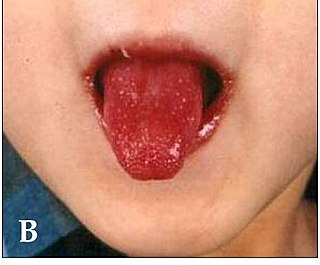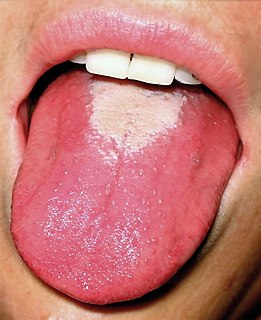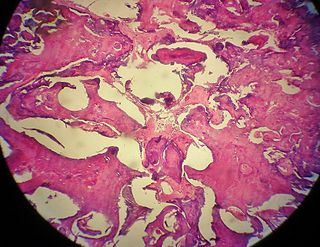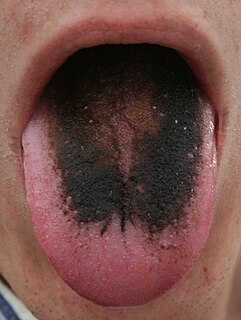
Giant-cell arteritis (GCA), also called temporal arteritis, is an inflammatory disease of blood vessels. Symptoms may include headache, pain over the temples, flu-like symptoms, double vision, and difficulty opening the mouth. Complication can include blockage of the artery to the eye with resulting blindness, aortic dissection, and aortic aneurysm. GCA is frequently associated with polymyalgia rheumatica.
Dysgeusia, also known as parageusia, is a distortion of the sense of taste. Dysgeusia is also often associated with ageusia, which is the complete lack of taste, and hypogeusia, which is a decrease in taste sensitivity. An alteration in taste or smell may be a secondary process in various disease states, or it may be the primary symptom. The distortion in the sense of taste is the only symptom, and diagnosis is usually complicated since the sense of taste is tied together with other sensory systems. Common causes of dysgeusia include chemotherapy, asthma treatment with albuterol, and zinc deficiency. Different drugs could also be responsible for altering taste and resulting in dysgeusia. Due to the variety of causes of dysgeusia, there are many possible treatments that are effective in alleviating or terminating the symptoms of dysgeusia. These include artificial saliva, pilocarpine, zinc supplementation, alterations in drug therapy, and alpha lipoic acid.
Bad breath, also known as halitosis, is a symptom in which a noticeably unpleasant breath odour is present. It can result in anxiety among those affected. It is also associated with depression and symptoms of obsessive compulsive disorder.

Head and neck cancer is a group of cancers that starts in the mouth, nose, throat, larynx, sinuses, or salivary glands. Symptoms for head and neck cancer may include a lump or sore that does not heal, a sore throat that does not go away, trouble swallowing, or a change in the voice. There may also be unusual bleeding, facial swelling, or trouble breathing.

Lichen planus is a chronic inflammatory and immune mediated disease that affects the skin, nails, hair, and mucous membranes. It is characterized by polygonal, flat-topped, violaceous papules and plaques with overlying, reticulated, fine white scale, commonly affecting dorsal hands, flexural wrists and forearms, trunk, anterior lower legs and oral mucosa. Although there is a broad clinical range of LP manifestations, the skin and oral cavity remain as the major sites of involvement. The cause is unknown, but it is thought to be the result of an autoimmune process with an unknown initial trigger. There is no cure, but many different medications and procedures have been used in efforts to control the symptoms.

Kawasaki disease, also known as mucocutaneous lymph node syndrome, is a disease in which blood vessels throughout the body become inflamed. The most common symptoms include a fever that lasts for more than five days not affected by usual medications, large lymph nodes in the neck, a rash in the genital area, and red eyes, lips, palms or soles of the feet. Other symptoms include sore throat and diarrhea. Within three weeks of the onset of symptoms, the skin from the hands and feet may peel. Recovery then typically occurs. In some children, coronary artery aneurysms may form in the heart after 1–2 years.

Fumagillin is a complex biomolecule and used as an antimicrobial agent. It was isolated in 1949 from the microbial organism Aspergillus fumigatus.

Glossitis can mean soreness of the tongue, or more usually inflammation with depapillation of the dorsal surface of the tongue, leaving a smooth and erythematous (reddened) surface,. In a wider sense, glossitis can mean inflammation of the tongue generally. Glossitis is often caused by nutritional deficiencies and may be painless or cause discomfort. Glossitis usually responds well to treatment if the cause is identified and corrected. Tongue soreness caused by glossitis is differentiated from burning mouth syndrome, where there is no identifiable change in the appearance of the tongue, and there are no identifiable causes.

Cowden syndrome is an autosomal dominant inherited condition characterized by benign overgrowths called hamartomas as well as an increased lifetime risk of breast, thyroid, uterine, and other cancers. It is often underdiagnosed due to variability in disease presentation, but 99% of patients report mucocutaneous symptoms by age 20-29. Despite some considering it a primarily dermatologic condition, Cowden's syndrome is a multi-system disorder that also includes neurodevelopmental disorders such as macrocephaly.

Geographic tongue, also known by several other terms, is an inflammatory condition of the mucous membrane of the tongue, usually on the dorsal surface. It is a common condition, affecting approximately 2–3% of the general population. It is characterized by areas of smooth, red depapillation which migrate over time. The name comes from the map-like appearance of the tongue, with the patches resembling the islands of an archipelago. The cause is unknown, but the condition is entirely benign, and there is no curative treatment. Uncommonly, geographic tongue may cause a burning sensation on the tongue, for which various treatments have been described with little formal evidence of efficacy.

An odontoma, also known as an odontome, is a benign tumour linked to tooth development. Specifically, it is a dental hamartoma, meaning that it is composed of normal dental tissue that has grown in an irregular way. It includes both odontogenic hard and soft tissues.
Choristomas, a form of heterotopia, are closely related benign tumors found in abnormal locations.
Congenital mesoblastic nephroma, while rare, is the most common kidney neoplasm diagnosed in the first three months of life and accounts for 3-5% of all childhood renal neoplasms. This neoplasm is generally non-aggressive and amenable to surgical removal. However, a readily identifiable subset of these kidney tumors has a more malignant potential and is capable of causing life-threatening metastases. Congenital mesoblastic nephroma was first named as such in 1967 but was recognized decades before this as fetal renal hamartoma or leiomyomatous renal hamartoma.

Tongue diseases can be congenital or acquired, and are multiple in number. Considered according to a surgical sieve, some example conditions which can involve the tongue are discussed below. Glossitis is a general term for tongue inflammation, which can have various etiologies, e.g. infection.
Eccrine angiomatous hamartoma (EAH), first described by Lotzbeck in 1859, is a rare benign vascular hamartoma characterized histologically by a proliferation of eccrine and vascular components. EAH exists on a spectrum of cutaneous tumors that include eccrine nevus, mucinous eccrine nevus and EAH. Each diagnostic subtype is characterized by an increase in the number as well as size of mature eccrine glands or ducts, with EAH being distinguished by the added vascular component.
Oral submucous fibrosis is a chronic, complex, premalignant condition of the oral cavity, characterized by juxta-epithelial inflammatory reaction and progressive fibrosis of the submucosal tissues. As the disease progresses, the jaws become rigid to the point that the person is unable to open the mouth. The condition is remotely linked to oral cancers and is associated with areca nut or betel quid chewing, a habit similar to tobacco chewing, is practiced predominantly in Southeast Asia and India, dating back thousands of years.

Silicone granulomas are a skin condition that occur as a reaction to liquid silicones, and are characterized by the formation of nodules.
Oral pigmentation is asymptomatic and does not usually cause any alteration to the texture or thickness of the affected area. The colour can be uniform or speckled and can appear solitary or as multiple lesions. Depending on the site, depth, and quantity of pigment, the appearance can vary considerably.
Multifocal micronodular pneumocyte hyperplasia (MMPH) is a subtype of pneumocytic hyperplasia.











